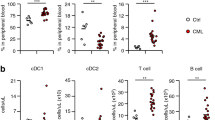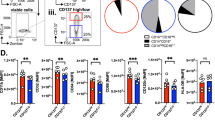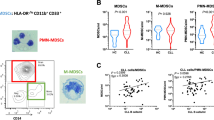Abstract
Chronic lymphocytic leukemia (CLL) is characterized by apoptosis resistance and a dysfunctional immune system. Previous reports suggested a potential role of myeloid cells in mediating these defects. However, the composition and function of CLL-associated myeloid cells have not been thoroughly investigated in vivo. Using the Eμ-TCL1 mouse model, we observed severe skewing of myeloid cell populations with CLL development. Monocytes and M2-like macrophages infiltrated the peritoneal cavity of leukemic mice. Monocytes also accumulated in the spleen in a CCR2-dependent manner, and were severely skewed toward Ly6Clow patrolling or nonclassical phenotype. In addition, the percentage of MHC-IIhi dendritic cells and macrophages significantly dropped in the spleen. Gene expression profiling of CLL-associated monocytes revealed aberrantly high PD-L1 expression and secretion of multiple inflammatory and immunosuppressive cytokines like interleukin-10, tumor necrosis factor-α and CXCL9. In vivo myeloid cell depletion using liposomal Clodronate resulted in a significant control of CLL development accompanied by a pronounced repair of innate immune cell phenotypes and a partial resolution of systemic inflammation. In addition, CLL-associated skewing of T cells toward antigen-experienced phenotypes was repaired. The presented data suggest that targeting nonmalignant myeloid cells might serve as a novel immunotherapeutical strategy for CLL.
This is a preview of subscription content, access via your institution
Access options
Subscribe to this journal
Receive 12 print issues and online access
$259.00 per year
only $21.58 per issue
Buy this article
- Purchase on Springer Link
- Instant access to full article PDF
Prices may be subject to local taxes which are calculated during checkout







Similar content being viewed by others
References
Zenz T, Mertens D, Kuppers R, Dohner H, Stilgenbauer S . From pathogenesis to treatment of chronic lymphocytic leukaemia. Nat Rev Cancer 2010; 10: 37–50.
Burger JA, Ghia P, Rosenwald A, Caligaris-Cappio F . The microenvironment in mature B-cell malignancies: a target for new treatment strategies. Blood 2009; 114: 3367–3375.
Burger JA, Tsukada N, Burger M, Zvaifler NJ, Dell'Aquila M, Kipps TJ . Blood-derived nurse-like cells protect chronic lymphocytic leukemia B cells from spontaneous apoptosis through stromal cell-derived factor-1. Blood 2000; 96: 2655–2663.
Seiffert M, Schulz A, Ohl S, Döhner H, Stilgenbauer S, Lichter P . Soluble CD14 is a novel monocyte-derived survival factor for chronic lymphocytic leukemia cells, which is induced by CLL cells in vitro, and present at abnormally high levels in vivo. Blood 2010; 116: 4223–4230, ..
Schulz A, Toedt G, Zenz T, Stilgenbauer S, Lichter P, Seiffert M . Inflammatory cytokines and signaling pathways are associated with survival of primary chronic lymphocytic leukemia cells in vitro: a dominant role of CCL2. Haematologica 2011; 96: 408–416.
Carlin LM, Stamatiades EG, Auffray C, Hanna RN, Glover L, Vizcay-Barrena G et al. Nr4a1-dependent Ly6C(low) monocytes monitor endothelial cells and orchestrate their disposal. Cell 2013; 153: 362–375.
Nahrendorf M, Swirski FK, Aikawa E, Stangenberg L, Wurdinger T, Figueiredo JL et al. The healing myocardium sequentially mobilizes two monocyte subsets with divergent and complementary functions. J Exp Med 2007; 204: 3037–3047.
Shi C, Pamer EG . Monocyte recruitment during infection and inflammation. Nat Rev Immunol 2011; 11: 762–774.
Richards D, Hettinger J, Feuerer M . Monocytes and macrophages in cancer: development and functions. Cancer Microenviron 2013; 6: 179–191.
Movahedi K, Laoui D, Gysemans C, Baeten M, Stange G, Van den Bossche J et al. Different tumor microenvironments contain functionally distinct subsets of macrophages derived from Ly6C(high) monocytes. Cancer Res 2010; 70: 5728–5739.
Franklin RA, Liao W, Sarkar A, Kim MV, Bivona MR, Liu K et al. The cellular and molecular origin of tumor-associated macrophages. Science 2014; 344: 921–925.
Gabrilovich DI, Ostrand-Rosenberg S, Bronte V . Coordinated regulation of myeloid cells by tumours. Nat Rev Immunol 2012; 12: 253–268.
Riches JC, Gribben JG . Understanding the immunodeficiency in chronic lymphocytic leukemia: potential clinical implications. Hematol Oncol Clin North Am 2013; 27: 207–235.
McClanahan F, Hanna B, Miller S, Clear AJ, Lichter P, Gribben JG et al. PD-L1 checkpoint blockade prevents immune dysfunction and leukemia development in a mouse model of chronic lymphocytic leukemia. Blood 2015; 126: 203–211.
Ysebaert L, Fournie JJ . Genomic and phenotypic characterization of nurse-like cells that promote drug resistance in chronic lymphocytic leukemia. Leuk Lymphoma 2011; 52: 1404–1406.
Gustafson MP, Abraham RS, Lin Y, Wu W, Gastineau DA, Zent CS et al. Association of an increased frequency of CD14+ HLA-DR lo/neg monocytes with decreased time to progression in chronic lymphocytic leukaemia (CLL). Br J Haematol 2012; 156: 674–676.
Jitschin R, Braun M, Buttner M, Dettmer-Wilde K, Bricks J, Berger J et al. CLL-cells induce IDOhi CD14+HLA-DRlo myeloid-derived suppressor cells that inhibit T-cell responses and promote TRegs. Blood 2014; 124: 750–760.
Herishanu Y, Perez-Galan P, Liu D, Biancotto A, Pittaluga S, Vire B et al. The lymph node microenvironment promotes B-cell receptor signaling, NF-kappaB activation, and tumor proliferation in chronic lymphocytic leukemia. Blood 2010; 117: 563–574.
Bichi R, Shinton SA, Martin ES, Koval A, Calin GA, Cesari R et al. Human chronic lymphocytic leukemia modeled in mouse by targeted TCL1 expression. Proc Natl Acad Sci USA 2002; 99: 6955–6960.
Hofbauer JP, Heyder C, Denk U, Kocher T, Holler C, Trapin D et al. Development of CLL in the TCL1 transgenic mouse model is associated with severe skewing of the T-cell compartment homologous to human CLL. Leukemia 2011; 25: 1452–1458.
Gorgun G, Ramsay AG, Holderried TA, Zahrieh D, Le Dieu R, Liu F et al. E(mu)-TCL1 mice represent a model for immunotherapeutic reversal of chronic lymphocytic leukemia-induced T-cell dysfunction. Proc Natl Acad Sci USA 2009; 106: 6250–6255.
Kuziel WA, Morgan SJ, Dawson TC, Griffin S, Smithies O, Ley K et al. Severe reduction in leukocyte adhesion and monocyte extravasation in mice deficient in CC chemokine receptor 2. Proc Natl Acad Sci USA 1997; 94: 12053–12058.
Gautier EL, Ivanov S, Lesnik P, Randolph GJ . Local apoptosis mediates clearance of macrophages from resolving inflammation in mice. Blood 2013; 122: 2714–2722.
Ghosn EE, Cassado AA, Govoni GR, Fukuhara T, Yang Y, Monack DM et al. Two physically, functionally, and developmentally distinct peritoneal macrophage subsets. Proc Natl Acad Sci USA 2010; 107: 2568–2573.
Sica A, Mantovani A . Macrophage plasticity and polarization: in vivo veritas. J Clin Invest 2012; 122: 787–795.
Swirski FK, Nahrendorf M, Etzrodt M, Wildgruber M, Cortez-Retamozo V, Panizzi P et al. Identification of splenic reservoir monocytes and their deployment to inflammatory sites. Science 2009; 325: 612–616.
Liao F, Ali J, Greene T, Muller WA . Soluble domain 1 of platelet-endothelial cell adhesion molecule (PECAM) is sufficient to block transendothelial migration in vitro and in vivo. J Exp Med 1997; 185: 1349–1357.
Liao F, Huynh HK, Eiroa A, Greene T, Polizzi E, Muller WA . Migration of monocytes across endothelium and passage through extracellular matrix involve separate molecular domains of PECAM-1. J Exp Med 1995; 182: 1337–1343.
Steidl U, Haas R, Kronenwett R . Intercellular adhesion molecular 1 on monocytes mediates adhesion as well as trans-endothelial migration and can be downregulated using antisense oligonucleotides. Ann Hematol 2000; 79: 414–423.
Zanesi N, Aqeilan R, Drusco A, Kaou M, Sevignani C, Costinean S et al. Effect of rapamycin on mouse chronic lymphocytic leukemia and the development of nonhematopoietic malignancies in Emu-TCL1 transgenic mice. Cancer Res 2006; 66: 915–920.
Burger JA, Quiroga MP, Hartmann E, Bürkle A, Wierda WG, Keating MJ et al. High-level expression of the T-cell chemokines CCL3 and CCL4 by chronic lymphocytic leukemia B cells in nurselike cell cocultures and after BCR stimulation. Blood 2009; 113: 3050–3058.
Sallusto F, Lanzavecchia A, Mackay CR . Chemokines and chemokine receptors in T-cell priming and Th1/Th2-mediated responses. Immunol Today 1998; 19: 568–574.
Griffith JW, Sokol CL, Luster AD . Chemokines and chemokine receptors: positioning cells for host defense and immunity. Annu Rev Immunol 2014; 32: 659–702.
Zeisberger SM, Odermatt B, Marty C, Zehnder-Fjallman AH, Ballmer-Hofer K, Schwendener RA . Clodronate-liposome-mediated depletion of tumour-associated macrophages: a new and highly effective antiangiogenic therapy approach. Br J Cancer 2006; 95: 272–281.
Song K, Herzog BH, Sheng M, Fu J, McDaniel JM, Chen H et al. Lenalidomide inhibits lymphangiogenesis in preclinical models of mantle cell lymphoma. Cancer Res 2013; 73: 7254–7264.
Sunderkotter C, Nikolic T, Dillon MJ, Van Rooijen N, Stehling M, Drevets DA et al. Subpopulations of mouse blood monocytes differ in maturation stage and inflammatory response. J Immunol 2004; 172: 4410–4417.
Chen SS, Batliwalla F, Holodick NE, Yan XJ, Yancopoulos S, Croce CM et al. Autoantigen can promote progression to a more aggressive TCL1 leukemia by selecting variants with enhanced B-cell receptor signaling. Proc Natl Acad Sci USA 2013; 110: E1500–E1507.
Maffei R, Bulgarelli J, Fiorcari S, Bertoncelli L, Martinelli S, Guarnotta C et al. The monocytic population in chronic lymphocytic leukemia shows altered composition and deregulation of genes involved in phagocytosis and inflammation. Haematologica 2013; 98: 1115–1123.
Yan XJ, Albesiano E, Zanesi N, Yancopoulos S, Sawyer A, Romano E et al. B cell receptors in TCL1 transgenic mice resemble those of aggressive, treatment-resistant human chronic lymphocytic leukemia. Proc Natl Acad Sci USA 2006; 103: 11713–11718.
Jia L, Clear A, Liu FT, Matthews J, Uddin N, McCarthy A et al. Extracellular HMGB1 promotes differentiation of nurse-like cells in chronic lymphocytic leukemia. Blood 2014; 123: 1709–1719.
Coscia M, Pantaleoni F, Riganti C, Vitale C, Rigoni M, Peola S et al. IGHV unmutated CLL B cells are more prone to spontaneous apoptosis and subject to environmental prosurvival signals than mutated CLL B cells. Leukemia 2011; 25: 828–837.
Lia M, Carette A, Tang H, Shen Q, Mo T, Bhagat G et al. Functional dissection of the chromosome 13q14 tumor-suppressor locus using transgenic mouse lines. Blood 2012; 119: 2981–2990.
Stall AM, Farinas MC, Tarlinton DM, Lalor PA, Herzenberg LA, Strober S et al. Ly-1 B-cell clones similar to human chronic lymphocytic leukemias routinely develop in older normal mice and young autoimmune (New Zealand Black-related) animals. Proc Natl Acad Sci USA 1988; 85: 7312–7316.
Elinav E, Nowarski R, Thaiss CA, Hu B, Jin C, Flavell RA . Inflammation-induced cancer: crosstalk between tumours, immune cells and microorganisms. Nat Rev Cancer 2013; 13: 759–771.
Yona S, Kim KW, Wolf Y, Mildner A, Varol D, Breker M et al. Fate mapping reveals origins and dynamics of monocytes and tissue macrophages under homeostasis. Immunity 2013; 38: 79–91.
Perrot I, Blanchard D, Freymond N, Isaac S, Guibert B, Pacheco Y et al. Dendritic cells infiltrating human non-small cell lung cancer are blocked at immature stage. J Immunol 2007; 178: 2763–2769.
Scarlett UK, Rutkowski MR, Rauwerdink AM, Fields J, Escovar-Fadul X, Baird J et al. Ovarian cancer progression is controlled by phenotypic changes in dendritic cells. J Exp Med 2012; 209: 495–506.
Saulep-Easton D, Vincent FB, Le Page M, Wei A, Ting SB, Croce CM et al. Cytokine-driven loss of plasmacytoid dendritic cell function in chronic lymphocytic leukemia. Leukemia 2014; 28: 2005–2015.
Ramsay AG, Johnson AJ, Lee AM, Gorgun G, Le Dieu R, Blum W et al. Chronic lymphocytic leukemia T cells show impaired immunological synapse formation that can be reversed with an immunomodulating drug. J Clin Invest 2008; 118: 2427–2437.
Wherry EJ . T cell exhaustion. Nat Immunol 2011; 12: 492–499.
Riches JC, Davies JK, McClanahan F, Fatah R, Iqbal S, Agrawal S et al. T cells from CLL patients exhibit features of T-cell exhaustion but retain capacity for cytokine production. Blood 2013; 121: 1612–1621.
Kocher T, Asslaber D, Zaborsky N, Flenady S, Denk U, Reinthaler P et al. CD4+ T cells, but not non-classical monocytes, are dispensable for the development of chronic lymphocytic leukemia in the TCL1-tg murine model. Leukemia e-pub ahead of print 2 November 2015; doi:10.1038/leu.2015.307.
Allavena P, Signorelli M, Chieppa M, Erba E, Bianchi G, Marchesi F et al. Anti-inflammatory properties of the novel antitumor agent yondelis (trabectedin): inhibition of macrophage differentiation and cytokine production. Cancer Res 2005; 65: 2964–2971.
Pyonteck SM, Akkari L, Schuhmacher AJ, Bowman RL, Sevenich L, Quail DF et al. CSF-1 R inhibition alters macrophage polarization and blocks glioma progression. Nat Med 2013; 19: 1264–1272.
Ruffell B, Chang-Strachan D, Chan V, Rosenbusch A, Ho CM, Pryer N et al. Macrophage IL-10 blocks CD8+ T cell-dependent responses to chemotherapy by suppressing IL-12 expression in intratumoral dendritic cells. Cancer Cell 2014; 26: 623–637.
Woyach JA, Furman RR, Liu TM, Ozer HG, Zapatka M, Ruppert AS et al. Resistance mechanisms for the Bruton's tyrosine kinase inhibitor ibrutinib. N Engl J Med 2014; 370: 2286–2294.
Acknowledgements
We thank Shaun Miller at Barts Cancer Institute, Nirojah Vijitha at University Clinic of Essen and the microarray unit of the DKFZ Genomics and Proteomics Core Facility for providing valuable technical assistance. We also thank Dr Markus Feuerer and Dr Jan Hettinger for the fruitful discussions. This study was supported by the Helmholtz Virtual Institute ‘Understanding and overcoming resistance to apoptosis and therapy in leukemia’, by the German Cancer Aid, Grant no. 112069, and by the German José Carreras Foundation, Grant no. R12/27 and R14/23. NZ was supported by the Austrian FWF Firnberg-Grant T 516.
Author information
Authors and Affiliations
Corresponding author
Ethics declarations
Competing interests
The authors declare no conflict of interest.
Additional information
Supplementary Information accompanies this paper on the Leukemia website
Supplementary information
Rights and permissions
About this article
Cite this article
Hanna, B., McClanahan, F., Yazdanparast, H. et al. Depletion of CLL-associated patrolling monocytes and macrophages controls disease development and repairs immune dysfunction in vivo. Leukemia 30, 570–579 (2016). https://doi.org/10.1038/leu.2015.305
Received:
Revised:
Accepted:
Published:
Issue Date:
DOI: https://doi.org/10.1038/leu.2015.305
This article is cited by
-
EOMES is essential for antitumor activity of CD8+ T cells in chronic lymphocytic leukemia
Leukemia (2021)
-
The receptor of the colony-stimulating factor-1 (CSF-1R) is a novel prognostic factor and therapeutic target in follicular lymphoma
Leukemia (2021)
-
PI3K-p110δ contributes to antibody responses by macrophages in chronic lymphocytic leukemia
Leukemia (2020)
-
HDAC7 is an actionable driver of therapeutic antibody resistance by macrophages from CLL patients
Oncogene (2020)
-
Bone marrow dendritic cells support the survival of chronic lymphocytic leukemia cells in a CD84 dependent manner
Oncogene (2020)



